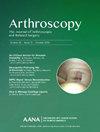关节镜下自体髂嵴移植与可调节环形悬吊装置治疗肩关节前方失稳伴盂兰盆骨缺损取得良好疗效
IF 4.4
1区 医学
Q1 ORTHOPEDICS
Arthroscopy-The Journal of Arthroscopic and Related Surgery
Pub Date : 2025-05-01
DOI:10.1016/j.arthro.2024.07.035
引用次数: 0
摘要
目的:本研究旨在评估关节镜下自体髂嵴移植术(AICG)与可调环悬吊固定装置在治疗伴有盂骨缺损的肩关节前不稳定(ASI)中的临床和放射学效果:对2017年1月至2020年12月期间接受关节镜AICG与可调环悬吊固定装置手术的患者进行回顾性研究。研究纳入了创伤性人工关节置换术、明显盂骨缺损和至少随访24个月的患者。患者报告结果(PROs)包括牛津肩关节不稳定性评分(OSIS)、Rowe评分、Walch-Duplay评分、Constant评分和视觉模拟评分(VAS)。术前和术后均使用计算机断层扫描(CT)进行了放射学评估。此外,还记录了活动范围、复发事件和并发症等其他数据:研究共纳入了 42 名患者,平均随访时间为 35.2 个月,从 25.1 个月到 55.9 个月不等。术前平均OSIS、Rowe评分、Walch-Duplay评分和Constant评分分别从24.4±7.2、25.0±9.0、25.2±9.8、87.5±7.1显著改善至最后一次随访时的42.4±4.9、92.4±8.1、87.9±8.3、93.6±4.5。所有患者的OSIS、Rowe和Walch-Duplay评分都超过了最小临床意义差异(MCID)。移植物结合率为100%,盂状关节面积从术前的82.5%显著增加到最后随访时的100.1%。没有患者再次出现不稳定。记录在案的两例并发症包括一例供体部位周围的疼痛和一例术后肩部僵硬:结论:关节镜 AICG 手术采用了可调环悬吊固定装置,其结果表明植骨固定稳定,植骨整合率高,临床效果良好,并发症发生率低。此外,在随访期间,移植物的重塑显著恢复了下盂的宽度和凹度,促进了整体恢复:证据级别:IV级,回顾性病例系列。本文章由计算机程序翻译,如有差异,请以英文原文为准。
Arthroscopic Autologous Iliac Crest Grafting With an Adjustable-Loop Suspensory Device Yields Favorable Outcomes for Anterior Shoulder Instability With Glenoid Defects
Purpose
To evaluate the clinical and radiologic outcomes of the arthroscopic autologous iliac crest grafting (AICG) procedure with an adjustable-loop suspensory fixation device in the treatment of anterior shoulder instability with glenoid bone defects.
Methods
A retrospective review was conducted on the patients who underwent arthroscopic AICG with an adjustable-loop suspensory fixation device from January 2017 to December 2020. Patients with traumatic anterior shoulder instability, significant glenoid bone defects, and a minimum follow-up of 24 months were included. Patient-reported outcomes, including the Oxford Shoulder Instability Score (OSIS), the Rowe score, the Walch-Duplay score, the Constant score, and the visual analog scale score, were compared preoperatively and postoperatively. Radiologic assessments using computed tomography were performed before and after the procedure. Additional data on active range of motion, recurrence events, and complications were recorded.
Results
A total of 42 patients were included in the study, with a mean follow-up time of 35.2 months, ranging from 25.1 to 55.9 months. Mean preoperative OSIS, Rowe score, Walch-Duplay score, and Constant score significantly improved from 24.4 ± 7.2, 25.0 ± 9.0, 25.2 ± 9.8, 87.5 ± 7.1 to 42.4 ± 4.9, 92.4 ± 8.1, 87.9 ± 8.3, and 93.6 ± 4.5 at the last follow-up, respectively. All patients exceeded the minimal clinically important difference for OSIS, Rowe, and Walch-Duplay scores. The graft union rate was 100%, and the glenoid area increased significantly from 82.5% preoperatively to 100.1% at the final follow-up. No patient experienced a recurrence of instability. Two recorded complications included one case of dysesthesia around the donor site and one case of postoperative shoulder stiffness.
Conclusions
The outcomes of the arthroscopic AICG procedure, which uses an adjustable-loop suspensory fixation device, demonstrated stable bone graft fixation, high rates of graft integration, favorable clinical results, and a low incidence of complications. Moreover, the remodeling of the graft during the follow-up period significantly restored the width and concavity of the inferior glenoid, contributing to the overall recovery.
Level of Evidence
Level IV, retrospective case series.
求助全文
通过发布文献求助,成功后即可免费获取论文全文。
去求助
来源期刊
CiteScore
9.30
自引率
17.00%
发文量
555
审稿时长
58 days
期刊介绍:
Nowhere is minimally invasive surgery explained better than in Arthroscopy, the leading peer-reviewed journal in the field. Every issue enables you to put into perspective the usefulness of the various emerging arthroscopic techniques. The advantages and disadvantages of these methods -- along with their applications in various situations -- are discussed in relation to their efficiency, efficacy and cost benefit. As a special incentive, paid subscribers also receive access to the journal expanded website.

 求助内容:
求助内容: 应助结果提醒方式:
应助结果提醒方式:


